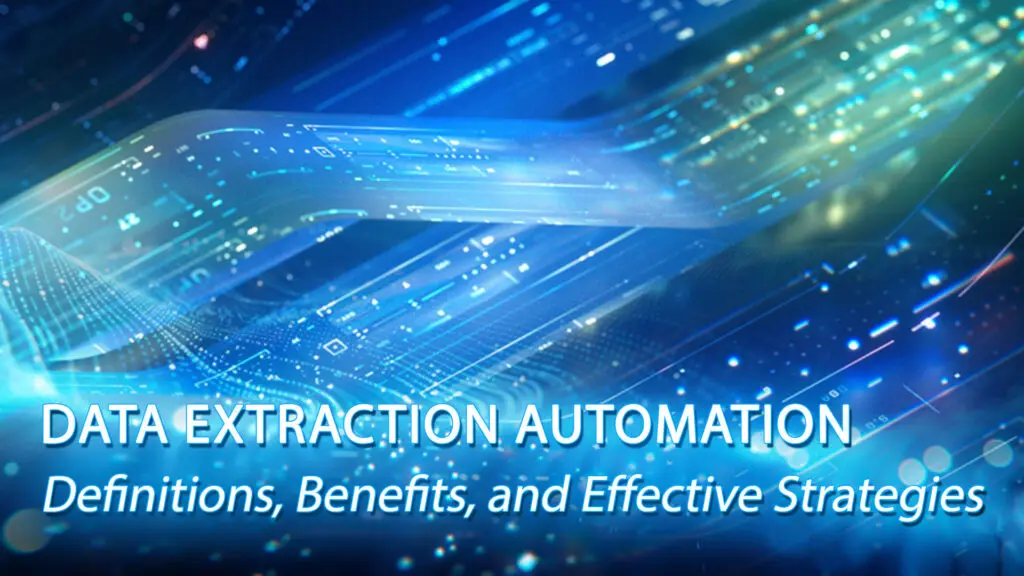Data extraction automation is an important technology that helps businesses automatically collect data from various sources such as documents and websites. This step converts data into structured, usable formats. In contrast to manual methods that are slow and prone to errors, automating data extraction uses software and AI to improve efficiency.
Join DIGI-TEXX in this article to explore automated data extraction, including definition, data extraction technology (AI, OCR), benefits, applications, software options, and strategies for choosing the right vendor.

What Is Automated Data Extraction?

Data extraction automation is the process of using software tools to collect, process, and organize data from different sources into a usable format -without manual work.
Unlike traditional methods, which are slow and prone to errors, automation leverages technologies like AI, ML, and OCR to speed up tasks and reduce human input.
Modern systems can handle all types of data—from databases to emails and even social media—while AI techniques like Natural Language Processing add the ability to interpret and understand information more accurately.
=> You might like: Revolutionizing Business Efficiency with Automated Document Processing
What Is An Example Of Data Extraction?
To better understand the application and practicality of data extraction automation, here are some examples where automation significantly improves the end-to-end efficiency and accuracy compared to human intervention:
Email analysis
Businesses often receive large volumes of emails containing valuable information, such as order confirmations or customer inquiries. Automated data extraction tools can automatically scan these emails and identifying specific data points.
This extracted information can then be fed directly into a Customer Relationship Management (CRM) system, spreadsheet, or other type of database, completely eliminating manual data entry and reducing the risk of errors.
Document Processing (Invoices and Contracts)
Organizations across many industries process a myriad of documents such as invoices, purchase orders, and contracts.
Using technologies such as OCR combined with AI and NLP, automated data extraction systems can scan these documents (whether digitally or physically) and extract important information.
For example, from an invoice, the system can extract the supplier name, invoice number, issue date, due date, invoice item details (description, quantity, price), and total amount due.
Similarly, tools can automatically extract data from contracts, identifying key terms, effective dates, renewal terms, and specific obligations, storing this structured data for easier management, compliance auditing, and analysis.
This extracted data is often automatically fed into accounting software or contract management systems.
Web scraping
Companies often need to monitor external websites for daily information about competitors, market trends, or customer feedback in the industry.
Data scraping tools, often called web crawlers, can be programmed to navigate websites and automatically collect specific information.
Examples include collecting product prices and specifications from competitor sales pages, collecting customer reviews to analyze trends, or extracting articles relevant to a specific industry.
This helps businesses stay informed and respond quickly to market changes by automating data extraction.
=> See more: Real-Time Data Scraping: How It Works and Why It Matters

Types of Data for Automated Extraction
Understandably, the efficiency and complexity of automated data extraction will depend largely on the type of data required to be processed. The main types of data are typically classified as follows:
Structured Data
Structured data is defined by data that is organized and follows a pre-defined format with established rules, usually stored in a database or spreadsheet.
This data follows a fixed pattern, meaning that the data type for each field (column) is pre-defined and records (rows) will always contain the same type of information.
This organization makes the data structured and easy to search, retrieve and analyze using database query languages such as SQL and other data management tools.
Common examples of this type include customer information in a CRM system, financial transaction records in an accounting software, and inventory details in a management system. When it comes to data extraction, structured data is the simplest form of data extraction automation.

Unstructured Data
Unstructured data is the opposite of the above concept, it does not have any pre-defined format or rules. The data does not fit neatly into rows and columns and comes in a variety of forms, such as plain text documents, emails, social media posts, images, audio, and video.
The nature of this type of data makes it difficult to process and analyze using traditional data tools.
Extracting meaningful information from unstructured data often requires advanced technologies such as Natural Language Processing (NLP) to understand text, Machine Learning (ML) to identify patterns, and Computer Vision to interpret images.
Examples of this type of data include email content, customer reviews, PDF reports, legal contracts, handwritten notes, and multimedia files. AI/ML-based automated data extraction methods are suitable tools for processing this type of data.
Semi-Structured Data
Semi-structured data is a concept that falls between structured data and unstructured data. Although it does not follow the column and row organization, it contains organizational tags, markers, or hierarchies that separate data elements and provide a specific level of structure.
This makes the data more organized than unstructured data but more flexible than structured data, as its structure can often be modified without changing the nature of the data.
Common formats for semi-structured data include XML files, JSON files, commonly used for transmitting data over the web. These two file types are commonly used by websites to reduce web space, in email content and system log files.
Solutions such as DIGI-XTRACT from DIGI-TEXX are designed to efficiently process structured, semi-structured and unstructured documents through data extraction automation.

Numerical Data
Numerical data is quantitative information that is represented entirely in numbers. It is the basis for statistical analysis, mathematical modeling, financial calculations and performance measurement.
Numerical data can be discrete (representing items that can be counted, such as the number of units sold) or continuous (representing measurements over a range, such as average temperature or revenue).
When analyzing this type of data, accuracy in data extraction is important, especially for data-driven decision making. The right data allows the person holding the data to make accurate calculations, comparisons, and trend analysis, and vice versa.
Specific examples of this type of data include sales figures, sensor data from IoT devices, financial figures, transaction amounts on invoices, or credit card statements.
Textual data
Textual data includes online or printed articles that convey information through language. This data is ubiquitous in almost every business, appearing in documents, reports, emails, websites, and more.
While text data can sometimes be organized into semi-structured data, such as forms or tables in a document, it is often unstructured in nature (e.g., email content or legal contracts).
Extracting specific, meaningful information from text data often requires the use of Natural Language Processing (NLP) techniques. This approach mines text for patterns, analyzes sentiment to assess sentiment, and identifies specific items such as names, dates, and organizations in text.
Examples of this type of data include: contracts and agreements, invoices and receipts, research papers, customer support tickets, and industry articles.

How Data Extraction Automation Works?
Data extraction automation helps businesses quickly collect and organize information from different sources without much manual effort. Instead of spending hours sorting through messy or unstructured data, the system turns it into something clear and usable. It’s designed to handle complex formats that are tough to process by hand. Key technologies enabling this include:
AI and Machine Learning Integration
Artificial Intelligence (AI) and Machine Learning (ML) are the foundation for modern data extraction automation. Unlike traditional methods that rely on predefined rules, AI-powered systems will have the ability to learn from data.
- Learning and Adapting: ML algorithms, through supervised learning (using labeled data samples) and unsupervised learning (identifying patterns in unlabeled data), enable the system to recognize complex data patterns, improve extraction accuracy over time through feedback, and adapt to variations in document layout and data structure.
=> For example, DIGI-TEXX’s DIGI-XTRACT solution will leverage ML and Deep Learning (DL) technologies to enhance the quality of automated data extraction across a wide range of documents and can understand most definitions and contexts across multiple industries.
- Unstructured data processing: AI/ML technology will excel where rule-based analytics systems struggle, especially with unstructured data. Techniques like deep learning mimic human neural networks to recognize patterns in large data sets with high accuracy.
- Advanced capabilities: AI integration will also enable features like multilingual support and more sophisticated validation checks. Academic research has demonstrated the power of AI/ML in automating data extraction tasks.

Optical Character Recognition (OCR)
Optical Character Recognition (OCR) technology serves as the foundation for automated data extraction, especially when dealing with documents that are not physically sourced, images or PDFs.
The main function of this technology is to convert images of typed, handwritten or printed text into text data on a computer. This conversion makes the text content more accessible and easier to process.
The OCR technology application process includes the following steps:
1. Image collection: Scan or photograph the document.
2. Preprocessing: Clean the image to improve the accuracy of the writing. Such as skewing (correcting tilt), denoising (removing noise and bright spots) and enhancing contrast.
3. Text recognition: The system will now apply algorithms (such as pattern matching or feature extraction) to identify characters and words in the image processed in the previous step.
4. Post-processing: Post-processing converts image-based text into editable plain text. Modern OCR systems can handle complex layouts and fonts, achieving 80–90% accuracy. Advanced IDP solutions use AI to boost accuracy and automate data extraction from documents like invoices, receipts, and bank statements.
Natural Language Processing (NLP)
Natural Language Processing (NLP) is a branch of AI technology that enables computers to understand, interpret, and derive meaning from human language, both written and spoken.
It plays a key role in data extraction automation by unlocking valuable information contained in textual or unstructured data, such as emails, reports, legal contracts, social media comments, and customer feedback.

Key NLP techniques used in automated data extraction include:
- Text Recognition/Classification: Identifying the content of text and classifying documents based on their content (e.g., classifying which emails are requests and which are complaints).
- Named Entity Recognition (NER): Identifying and classifying specific entities in text, such as names of people, organizations, places, dates, monetary values, and product names.
- Sentiment Analysis: This step identifies the emotional states (positive, negative, neutral) expressed in the text, which is valuable for analyzing customer feedback or how users are referring to brands on social media.
- Relationship Extraction: Identifying relationships between things (e.g. linking a company name to its address elsewhere in the text). NLP techniques help automate tasks that traditionally require a lot of human intervention and resources..
Scalability and Flexibility
For automated data extraction solutions to function well in today’s environment, they must be scalable and flexible.
- Scalability: Represents the system’s ability to handle increasing volumes of data and processing requirements without sacrificing performance or increasing costs. An effective data extraction automation solution must be able to flexibly scale to accommodate growth, ensuring consistent performance.
- Flexibility: Includes the system’s ability to adapt to ever-changing business requirements, multiple data formats (structured, semi-structured, unstructured), multiple document layouts, and multiple data sources.
Integration with Existing Systems
The value of automated data extraction is enhanced when it can integrate seamlessly into the existing IT ecosystem of the organization and company.
- Importance: The solution must be integrated with core systems such as Customer Relationship Management (CRM), Enterprise Resource Planning (ERP), accounting software, databases, and document management systems.
- Methods and tools: Integration capabilities will typically be through APIs, middleware platforms, ESBs, or ETL/ELT tools.
- Best Practice: Successful integration requires careful and meticulous planning, including defining goals, understanding existing data flows, ensuring data quality and governance, implementing strong security measures.

The Benefits of Automating Data Extraction for Businesses
Automating data extraction offers many tangible benefits. It replaces manual and resource-intensive processes in businesses with technology-driven and highly efficient solutions. The key benefits of data extraction automation include:
- Increased efficiency and speed: Automation significantly reduces the time required to enter and process data. Tasks that used to take hours or even days can now be completed in minutes or seconds. This acceleration speeds up the entire workflow, from invoice processing to customer onboarding.
- Improved data accuracy and reliability: Manual data entry by humans can lead to errors that can have significant consequences later on. With technologies like OCR and AI, well-implemented data extraction automation solutions can achieve much higher accuracy rates.
- Significant Cost Reduction: The use of automated data ingestion implementation will directly reduce the operational and technology implementation costs.
- Improved Scalability: Manual data extraction processes will inevitably struggle to scale, whereas automated data extraction systems are designed to handle large data sets and help businesses scale their operations more smoothly as they change in size.
- Better Data and Information Management: Automation facilitates the consolidation of data from different sources into centralized data warehouses, which improves the accessibility and management of data for businesses.
- Improved compliance and risk management: Standardizing data processing through automating data extraction helps businesses comply with data privacy regulations (such as GDPR, HIPAA) and industry-specific compliance requirements.

Applications of Automated Data Extraction
The versatility of automated data extraction is applied in many different industries, helping to solve specific challenges related to large-volume data processing, data integration, and data analysis. The need to process many different types of data in the market today has led to data extraction automation becoming extremely necessary in all fields today.
Business Intelligence (BI)
In the field of Business Intelligence, automated data extraction plays an important role in providing data to popular data analysis platforms. It supports automatic retrieval of data from various operational systems (such as CRM, ERP, sales platforms, web analytics tools) and external sources.
Ultimately, the systematic data will be used to generate business reports, thereby making faster, more informed decisions, based on real-time data instead of relying on manually collected data.

E-commerce
The e-commerce industry is growing rapidly, businesses that can take advantage of data extraction automation will certainly create a competitive advantage.
For example, it is possible to deploy tools that automatically collect real-time pricing information, product descriptions and inventory status, create competitive positioning strategies when there is enough information about surrounding competitors, as well as analyze sentiment through customer reviews to be able to identify touch points that need improvement in the customer care process.
Finance
The finance industry, which depends heavily on data processing and requires high data accuracy, can be mentioned. For example, automatic invoice processing, automatic data extraction will help extract information fields faster from supplier invoices, thereby minimizing manual entry errors.
It can also reconcile bank and credit card statements by automatically extracting transaction details (date, description, amount) from bank and credit card statements.
It can also aggregate market data by automatically accessing and restructuring financial market data, thereby predicting and assessing market risks.

Healthcare
Healthcare providers often face challenges in managing large volumes of patient information and administrative documents.
With automated data extraction, it is easier to extract patient demographics, medical history, medications, etc. and automatically enter data into the Electronic Health Record (EHR) system.
It also supports the patient registration and admission process by automatically extracting information from patient registration forms to speed up the patient’s medical examination and treatment process.
Marketing
Marketing teams will be able to use automated data extraction to gather market intelligence for campaign planning, execution, and measurement.
For example, customer data aggregation, since customer information can be collected from multiple touchpoints (such as website forms, email interactions, social media profiles), manual data extraction can help structure this data to make accurate recommendations.
Additionally, it can also help marketers track campaign performance, such as automatically collecting metrics (clicks, conversions, engagement rates) from advertising platforms into various analytics tools to measure campaign effectiveness and optimize communication strategies.

Top 6 Best Data Extraction Automation Software
DIGI-XTRACT
DIGI-XTRACT stands out as one of the leading solutions in the data extraction automation category, providing businesses with maximum flexibility and efficiency in managing their data.
This service is an optimal solution for automating data extraction processes, supporting various document types, and can be customized to meet the specific languages and requirements of each client.
DIGI-XTRACT not only ensures high performance but also guarantees quality and API integration, effectively eliminating the need for manual data entry.
With web monitoring services for real-time tracking and automatic reporting, DIGI-XTRACT is the top choice for businesses looking to optimize their data processing workflows.
Matillion
Matillion positions itself as a cloud-native platform designed specifically for the modern data environment. It integrates both data extraction and transformation capabilities, helping users build end-to-end data pipelines.
Its key strengths lie in its pushdown optimization capabilities, leveraging the processing power of cloud data warehouses such as Snowflake, Databricks, Redshift, and BigQuery for efficient transformation.
It is best suited for organizations that have invested heavily in cloud data platforms and require robust, scalable, and integrated ETL/ELT capabilities to automate data extraction and transformation.
AWS Glue
AWS Glue is a fully managed, serverless data integration service from Amazon Web Services. The platform’s main advantage is its seamless integration into the broader AWS ecosystem, making it easier to work with services like S3, RDS, and Redshift.
Key features include automated schema discovery using a “data crawler,” a visual ETL editor for code-free development, and support for Python and Scala scripting.
Fivetran
Fivetran’s core value is to provide a “no-maintenance” data extraction experience. The brand aims to automate the complexity of data system management.
In particular, features like automatic schema change detection and adaptation, pre-built and standardized data models for faster insights, log-based change data capture (CDC) prioritization to minimize impact to source systems, and automatic connector updates contribute to its ease of use.
Fivetran handles connector maintenance, allowing data teams to focus on analytics rather than pipeline maintenance.
Airbyte
Airbyte stands out as the leading open-source data integration platform today. Its open-source nature provides flexibility and avoids vendor lock-in. Airbyte is best suited for organizations that value agility and have the technical expertise to manage an open-source tool (or opt for a cloud version)
Snowflake Snowpipe
Snowflake Snowpipe is not a general-purpose extraction tool, but rather a continuous data collection service designed specifically for Snowflake Data Cloud.
The purpose of the service is to load data into Snowflake tables in near real-time (typically within minutes) as new data files arrive in a designated cloud storage space (such as Amazon S3, Azure Blob Storage, or Google Cloud Storage).
The service operates serverless, automatically scales compute resources based on orders, processes data in small batches for low latency, and provides features such as automatic file format detection and data validation.
=> See more: Top 10 Data Extraction Tools for 2025
How to Choose the Best Automated Data Extraction Solution?
Choosing the right automated data extraction solution will require a rigorous evaluation process with specific criteria, and it is essential that businesses understand their needs, technical requirements, and long-term value before making a choice. The ultimate goal is to find an automated data extraction solution that not only meets current requirements but is also scalable and adaptable to future needs. Key criteria to consider include:
Intelligent data capture techniques
Evaluate the vendor’s core technology used for extraction, such as a basic OCR solution or a combination of more advanced techniques such as AI, ML, NLP, and Computer Vision (often packaged into a technology called Intelligent Document Processing – IDP).
You also need to consider what your specific business tasks are, for example if your business needs to process multiple types of documents at once, determine if automatic document classification is a must-have feature.
In addition, for specific tasks, businesses need to determine what type of data they will need to input. Different intelligence models will have different collection mechanisms that directly affect the final accuracy if you do not choose the right service provider.

Accuracy and reliability of results
Accuracy is extremely important, but it can vary between customers. Before starting with a provider, determine if their error rate is acceptable.
Important fields such as financial amounts or identification numbers may require near-perfect accuracy (e.g. 99.9%), while other fields may be able to accept slightly lower rates.
Keep in mind that the quality of the input documents will significantly affect the accuracy of the output data during automated data extraction.
Flexible storage solutions
Consider where and how the extracted data will be stored and accessed. Does the service provider offer secure cloud storage or can it be deployed on-premises if needed? Do they guarantee that your data will be safe in the event of a failure or disaster?
It is fair to say that cloud-based automated data extraction solutions often offer advantages in terms of scalability and accessibility, but careful consideration should be given to data security.

User-friendly interface with advanced features
Interface evaluation criteria are also quite important – is the interface designed for technical users, business users, or both? How much training will be required to become proficient?
Does the system they build provide workflow automation for document routing? Does the solution currently provide real-time monitoring dashboards and reporting functionality to track performance and identify existing issues in today’s social media landscape?
Cost-Effectiveness
Start by assessing the total cost of ownership (TCO) and understanding their pricing model – is it a monthly/annual subscription, or pay per document/page?
Also, make sure the included features match your actual needs to avoid paying for features you don’t need. Also, be clear about costs such as fees beyond certain volumes, access to premium support, or requesting custom reports.

In short, automated data extraction is now a strategy for businesses navigating the digital landscape. Manual methods are inefficient and error-prone, unable to meet modern data needs. Data extraction automation, leveraging AI, ML, OCR, and NLP, will help businesses find a faster, more accurate alternative to processing data. For businesses looking for expert guidance on automated data extraction, DIGI-TEXX offers proven solutions, significantly reducing the time to sign.
=> Read more:


